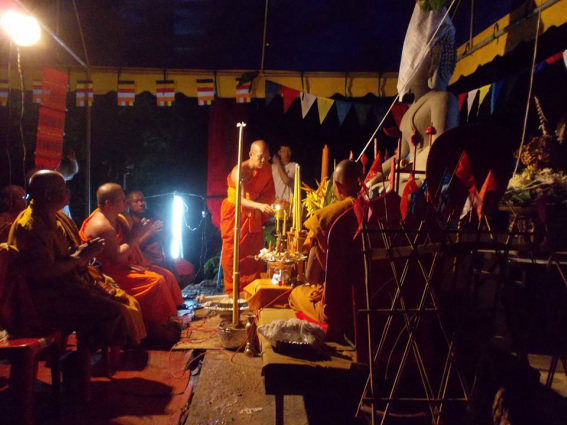|
An image of the Lord Buddha undergoes an impressive ceremony to begin its service inspiring reverence and evoking peace. At the climax of the ceremony the eyes of the image are symbolically opened. One of the best ways to understand the significance of Thai images of the Buddha or of the temple in which the image resides is to comprehend what the dedication ceremony means.
Dr. Kenneth E. Wells was a Presbyterian missionary in Thailand. He made a study of Thai Buddhism his avocation and in 1938-9 wrote what is still the most comprehensive and authoritative description of Thai Buddhist practices in English. He built his study around field observations which he supplemented with references to available texts in various languages. When his book Thai Buddhism was reprinted in 1960 and issued in Thai it became a standard reference work for Buddhist monks as well as the general public. He described a night-long dedication at Wat Tha Satoi, Chiang Mai in February 1937. Within the vihara was an altar with about two dozen bronze images of Buddha, and behind the altar and along the wall were four larger images made of brick and mortar covered with gold leaf. A sincana cord had been wound about from one image to another and one end of the string brought to the monk in the preaching chair. Most of the images were new and many of them had been brought from private homes to be consecrated in this Suat Poek ceremony. The eyes of the new images were sealed with wax and a cloth of white or of yellow was placed over the head and shoulders of each figure. The worshipers, seated on mats, extended from in front of the altar to the door of the vihara and even outside filling the portico in front. [Wells describes the night long series of chants.} The selections were intoned rather than read, and so chosen that the final chapter, recording the death of the Buddha and his attainment of Nibbana, was completed just before dawn. At this point a monk opened a window shutter revealing the first faint streaks of morning light to the group within. The monks then seated themselves facing the altar and the leader chanted the “Presentation of Incense and Candles” (thavai dhup tien). Then followed the “Consecration of the images of Buddha,” or Buddhabhiseka ceremony. In this the Namo and Saranagamana were chanted, followed by the Dhammacakkappavatana Sutra. Then the Buddha Udana Gatha was used and a portion of the Vipassanabhumi Patha. As they chanted “Whenever the Dharma is made manifest to a brahmana who is diligent, such a bramana can ward off Mara with all his attendants like the dawn drives away darkness and fills the air with light” a monk arose and led a few of the laity in the task of unveiling the images and removing the wax from their eyes. As the vihara faced east the eyes of the images were thus opened upon the first rays of the rising sun. This Buddhabhiseka Ceremony was spoken of as an ordination ceremony whereby the images entered the priesthood. Prior to this service the images were considered to be simply statues, after the service the images were “phra”, something worshipful and more than metal. They had become sacred and possessed of mana or spirit of intelligence. At the conclusion of the ceremony the khao madhupayasa or celestial food was placed before the newly consecrated images. (Wells, Kenneth, 1960. Thai Buddhism. Bangkok: The Christian Bookstore. Pp. 127-8) Wells provided two valuable references as footnotes to his text: The origin of this ceremony is found in India. There when a man has purchased an image, “It is his invariable practice to perform certain ceremonies called “Pran Pratishta” or the endowment of animation, by which he believes that its nature is changed from that of the mere materials of which it is formed and that it acquires not only life but supernatural powers.” L.S.S. O’Balley, Popular Hinduism, Macmillan & Co., New York, 1935, p. 26. In Cambodia images of Buddha are likewise consecrated by a ceremony in which the eyes of the statue are opened. “The Acaraya takes scissors and pretends to cut the hair of the statue. He does this three times, and each time he recites a Pali stanza called Pheak Kantray .... He then takes a razor and pretends to shave the head of the Buddha [as takes place whenever a man is ordained]. He does this three times and recites a stanza of Pali called Kamboet Kor .... Then he takes two needles and places them, one on the left hand and one on the right of the statue .... Then he takes the needle resting on the left hand and pretends to pierce the right eye of the statue; then he takes the needle on the right hand and touches the left eye with the point. All the worshipers then cry out three times in Pali, ‘We have now happily opened the eyes.’” Adhemard Leclere, Le Buddhisme au Cambodge, Paris, Ernest Leroux, 1899, p. 369. I have attended a dedication ceremony which included opening the eyes of the Buddha. It was missing the dawn symbolism, taking place within a two hour period in the evening. The meaning was the same, and no doubt has been the same for centuries. In the picture accompanying this essay, we see our friend Than Daeng lighting candles and incense. The Buddha image is made of bricks and mortar, completed by the monks seated before the image. Its eyes are covered with yellow wax and the head with a white cloth sack that will both be ceremoniously removed. Thus is the Lord Buddha awakened and invested with mana, animation.
0 Comments
Leave a Reply. |
AuthorRev. Dr. Kenneth Dobson posts his weekly reflections on this blog. Archives
March 2024
Categories |
| Ken Dobson's Queer Ruminations from Thailand |
|

 RSS Feed
RSS Feed
